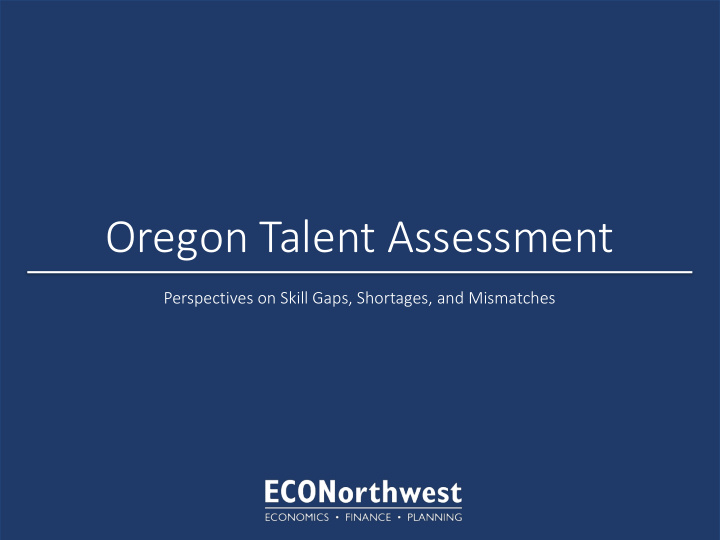



Oregon Talent Assessment Perspectives on Skill Gaps, Shortages, and Mismatches
Talent has supported strong job growth Total nonfarm employment, indexed (June 2009 = 100), Oregon and U.S. 125 Oregon U.S. 120 Oregon 115 110 U.S. 105 100 95 90 85 80 1 1 1 1 1 1 1 1 1 1 1 1 1 1 1 1 1 1 0 0 0 0 0 0 0 0 0 0 0 0 0 0 0 0 0 0 - - - - - - - - - - - - - - - - - - 6 2 6 2 6 2 6 2 6 2 6 2 6 2 6 2 6 2 0 1 0 1 0 1 0 1 0 1 0 1 0 1 0 1 0 1 - - - - - - - - - - - - - - - - - - 9 9 0 0 1 1 2 2 3 3 4 4 5 5 6 6 7 7 0 0 1 1 1 1 1 1 1 1 1 1 1 1 1 1 1 1 0 0 0 0 0 0 0 0 0 0 0 0 0 0 0 0 0 0 2 2 2 2 2 2 2 2 2 2 2 2 2 2 2 2 2 2 Data source: American Community Survey PUMS
Skill Problems
Categories of Skill Problems Skill Gaps : Widespread shortfalls in basic skills usually associated with a failure of the education system Skill Shortages : Shortfall of skills required by specific occupations Skill Mismatches : Supply and demand for skills is out of sync in either direction – oversupply or undersupply
Skill Gaps: Employers’ Perspectives Percent of survey respondents, by industry, who agree that applicants have the basic skills required for vacant positions Agree Disagree Don't Know/ Not Applicable All Sectors 77% Maritime 100% Energy 100% W ood Products 92% Other 83% Advanced Manufacturing 80% Healthcare 77% T echnology and Software Development 76% Food and Beverage 71% C onstruction 57% Bioscience 57% Outdoor Gear and Apparel 33% 0% 20% 40% 60% 80% 100% 5
Skill Gaps: What the Data Say Master's+ Bachelor's AA / some college HS diploma = 1 No HS diploma Data source: US Census; American Community Survey PUMS
Skill Shortages: Employers’ Perspectives Percent of survey respondents who identified specific hard or occupation skills that are hard to find C ritical/ analy tical thinking 63% Project management 34% Basic communication/ writing 32% Machine operation 24% C omputer software 24% 14% General office software Basic computer literacy 13% 0% 20% 40% 60% 80% 100% 7
Skill Shortages: Employers’ Perspectives Percent of survey respondents who identified specific soft or interpersonal skills that are hard to find C ommunication skills 71% Motivation 65% Dependability 63% T ime management 57% Leadership 44% T eamwork 36% Honesty 17% 0% 20% 40% 60% 80% 100% 8
Skill Shortages: What the Data Say Distribution of Oregon occupations by percentage point change in real median hourly wage, 2016 to 2017 Data source: US Bureau of Labor Statistics
Skill Mismatches: What the Data Say Share of college-educated 23-29 year old workers in occupations requiring college degrees 70% 60% U.S.: 56% 50% 40% 30% 20% 10% 0% VT NV OR KS KY NC NY NJ DE GA VA DC Y HI NH SC FL NM MT AK RI ME O OK AR N LA IL MO A IN PA MD MN A T SD T OH X AZ NE ID MA AL IA V MS ND MI I W C W C W U T W C T Data source: American Community Survey PUMS data and Oregon Employment Department
The Outlook
Sidelined Talent Late in the Economic Expansion Source: American Community Survey PUMS data; Ross & Holmes (2017), The Brookings Institution.
Job Market Rewarding Humans for Being Human High Social, High Math High Social, Low Math Predicted Low Social, High Actual Math Low Social, Low Math Source: Deming, D.J. (2017). The Growing Importance of Social Skills in the Labor Market. Quarterly Journal of Economics, vol. 132 issue 4.
2017-2027 Job Projections by Skill Emphasis More emphasis on clerical and service work More emphasis on communication and critical thinking More emphasis on physical work More emphasis on operating machines and processes 14
2017-2027 Job Projections by Skill Emphasis More emphasis on clerical and service work More emphasis on communication and critical thinking More emphasis on physical work More emphasis on operating machines and processes 15 Data sources: O*NET, Bureau of Labor Statistics, Oregon Employment Department, the Oregon Talent Plan
2017-2027 Job Projections by Skill Emphasis More emphasis on clerical and service work More emphasis on communication and critical thinking More emphasis on physical work More emphasis on operating machines and processes 16 Data sources: O*NET, Bureau of Labor Statistics, Oregon Employment Department, the Oregon Talent Plan
The Work Ahead
The Work Ahead 1. Humans have to get better at being human, which has broad implications for education and training delivery.
The Work Ahead 2. “Known knowns” in the occupational and skill forecasts are limited — but exist. They create the space for employer-educator collaboration (e.g., around project management, communication, and writing skills, plus occupations that serve an aging demography, hard-to-automate occupations, and occupations that will serve a growing state).
The Work Ahead 3. Oregonians who are unemployed or underemployed late in this economic expansion deserve priority attention as the state takes action under a new adult attainment goal.
Recommend
More recommend